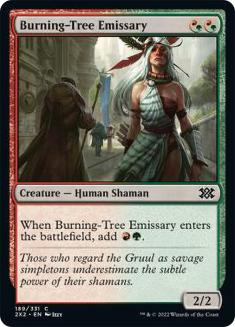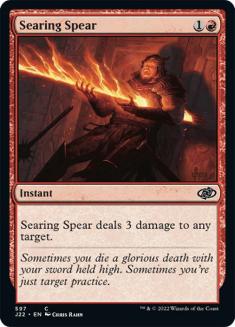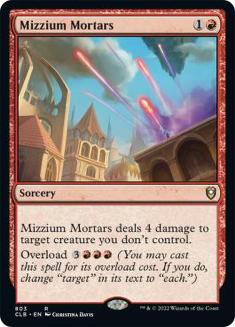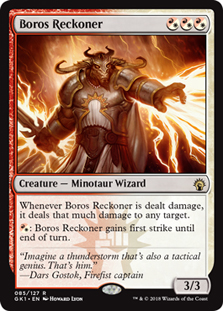Last week I had a bunch of theorycrafted red aggro lists. Between then and now I found a solid chunk of time to test them in event settings between Magic Online and real life. Rather than just present the results, I want to present the process in the format I try to use when testing in general.
Version 1
Creatures (37)
- 4 Stromkirk Noble
- 3 Pyreheart Wolf
- 2 Stonewright
- 4 Lightning Mauler
- 4 Ash Zealot
- 4 Gore-House Chainwalker
- 4 Rakdos Cackler
- 4 Burning-Tree Emissary
- 4 Firefist Striker
- 4 Boros Reckoner
Lands (19)
- 19 Mountain
Spells (4)
Sideboard

Why start with the nineteen-land list? Honestly, it just looked like more fun to jam some matches with. Also, there were more significant things to be learned here. The splash green list has a lot of cards I know are good, whereas this one has a lot more question marks. Even if this isn’t the right list, maybe something I learned from it would be transferable to the other builds; I wouldn’t get the same return from testing the more stock list.
Reckless Waif is still the filler card it was that randomly give you percentage on the play against blue control decks. It really isn’t necessary, and if I found better cards to cover the control matchup, it would immediately be out of the list.
Match 1: Sperling Bant Control
The low land count is really nice in this deck. My opponent kept getting two-for-ones on me game 1, but he started flooding and my virtual card advantage took over in the end.
Pyreheart Wolf and Boros Reckoner carry some serious weight. Reckoner actually gives you range to come back from behind by providing card advantage or stalling until you have real attacks. Wolf makes it so the midrange decks need so much more to win. Most of the traditional ways to beat red just fold to it: Loxodon Smiter, Thragtusk, any real blocker.
I feel like this list might be a little light on removal. Being able to clear a random second blocker to make Wolf or Firefist Striker maximally relevant would be nice.
Match 2: G/B/W Reanimator
Rhox Faithmender is really bad news for this deck. Good thing so few people are playing that one.
As noted in the previous match, the various Falter effects are very important against the Temple Garden decks.
Match 3: Red Aggro Mirror
The mirror is significantly faster than pre-Gatecrash. Pure attrition is much less relevant—or more accurately, only relevant if you can establish board parity first.
My opponent was splashing green, and those cards seem quite awesome here. Flinthoof Boar being a 3/3 is a big jump from Rakdos Cackler, Ash Zealot, and Burning-Tree Emissary, and Ghor-Clan Rampager as a 4/4 is actually just the biggest creature in either deck.
Overall Notes
Even with nineteen lands, you often find yourself with Hellrider mana. Having another big effect for the deck would be a nice way to push through later on. I’m unsure if you can support the full four Hellriders or event want to do so, but more than zero is likely correct.
Stonewright is awesome. It’s just the perfect scaling mana sink. It’s obviously not as efficient in damage output as being exactly on curve, but it’s always fine whether you are activating it zero, one, or four times a turn. Compare to something like Devil’s Play that is terrible at X=1 but fine at larger numbers or normal spells that are fine at their cost but not amazing when drawn later on and cast when you could cast something larger.
Version 2
Creatures (36)
- 4 Stromkirk Noble
- 3 Pyreheart Wolf
- 3 Hellrider
- 1 Stonewright
- 4 Lightning Mauler
- 4 Ash Zealot
- 2 Gore-House Chainwalker
- 4 Rakdos Cackler
- 4 Burning-Tree Emissary
- 3 Firefist Striker
- 4 Boros Reckoner
Lands (20)
- 20 Mountain
Spells (4)
Sideboard

Ignore all the numbers on this list, especially the sideboard. It was a pre-PTQ brew, not a calculated 75.
The fundamental takeaway is that I stuck with mono-red for a reason. I wanted to build a green splash list at first, but I quickly realized that Ghor-Clan Rampager wasn’t really something I was excited to play and neither was Rancor. I wanted all my cards to individually do something even if it was just a small damage source like Pyreheart Wolf. I didn’t want to be in a late game situation topdecking blanks. After that, it basically came down to whether I wanted to play eight nonbasics to splash Flinthoof Boar. It might be correct to do so, but I wasn’t 100% sold so I stuck with the deck as is.
Pre-Event Notes:
I honestly don’t think you can play four Hellrider with twenty lands. Not only is it stretching your mana base, but it also starts cutting into your Emissary plays since you are almost obligated to cut two-drops for it. The fourth and the 21st land were in the sideboard in case I determined that it was right to move back to the full set. Mountain was played as the 21st land because I never want to be looking at three lands that don’t cast Reckoner.
Skullcrack was a concession to the Turbo Fog deck as well as Omni Fog. I completely forgot about the damage prevention clause on it and otherwise would have cut the card. It’s also fine against Esper and other Revelation decks. Again, this is not an anti-Thragtusk card.
Match 4: Four-Color Reanimator
Suspicions confirmed. This deck was good against Reanimator before Gatecrash and only got better. They can do powerful things some of the time, but their less than perfect draws just flounder and die.
Match 5: Aristocrats
Boros Reckoner is simultaneously problematic and laughable for this deck. There really is no way for this deck to remove an opposing Reckoner without a massive loss of value aside from trading it for your own Reckoner. That said, this list is very good at making its opponent’s Reckoners unable to interact in any meaningful way. You have a similar number of Falter effects as Jund Aggro had actual removal.
It’s also worth noting that even if they can block through a Pyreheart Wolf with a Reckoner, you can still make strange attacks into it by ordering blockers properly. A 2/2 blocked by a Boros Reckoner is usually a disaster, but if they have to block with a Reckoner and a Lingering Souls token, you simply put the Spirit first and assign all the damage to it, making a normal sacrifice to push through damage instead of losing an additional creature to the Reckoner trigger.
The Aristocrats deck is quite clunky against your deck. Most of your solid draws feel like they should crush their average draw.
Match 6: R/G Aggro (similar to Ross Merriam Invitational deck)
The R/G deck is super soft to Boros Reckoner. They have zero ways to prevent it from doing exactly what the person playing Reckoner wants it to do against them. That deck could use some Dreadbores or really anything. I know Ross actually mentioned at this PTQ that he was playing Pyreheart Wolf in R/G now because of this.
Bonfire of the Damned is quite awkward for this deck. Almost all of your creatures fall into the sweet spot of toughness two or less where Bonfire can be cast to kill them in a reasonable timeframe. Obviously, Boros Reckoner and Hellrider survive, but beyond that you are looking at a one-sided Plague Wind. It’s worth considering if you can play around the card against decks that feature it since it’s just that bad of a blowout.
Again, this match emphasized that falling behind early in aggro mirrors is a big deal now. Burning-Tree Emissary is a big part of this because it’s actually possible to get more than a turn of mana out of a turn. The only real way this deck has to fight back is Emissarys of its own and Boros Reckoner. Plan for this when keeping hands on the draw or play in aggro mirrors. You need to be able to get on board fast and can’t afford to keep a clunky draw unless it is backed by Boros Reckoner.
Match 6: Naya Blitz
This matchup seems quite easy. You have more removal and Reckoners than they do, not to mention Stromkirk Noble being a boss.
The one way they can win is getting Champion of the Parish online (read: bigger than 3/3). Don’t let them do this. Kill it on sight.
This match brought up the question of what hands are keepable. A five-land hand is probably unkeepable unless it’s something like double Reckoner in an aggro mirror, but what about one land? While pre-Gatecrash mono-red was too dependent on high drops to consider one-land hands, I think that Burning-Tree Emissary opens up a new range of keepable hands.
Basically, really good Emissary draws with only one land are questionable, whereas non-Emissary one-landers are pretty much entirely unkeepable. The specific hand in question on the play was:
I am about 65% to hit a land in two draws, at which point I really have no idea how I can lose. Of course, this is a pretty optimized example for a specific matchup, but hopefully the general point gets across.
Match 7: Staticaster Jund
News flash: Izzet Staticaster is still a nightmare for this deck. I honestly don’t think there is much to do about this now as Staticaster is not a major concern, but if the format shifts to a bunch of decks playing that card, you are going to have to make a lot of drastically different deck choices (read: no 2/1s).
Huntmaster of the Fells is also a pretty big issue. It was before too, but cutting removal doesn’t help. You can afford to get two-for-oned on the token, but letting a Huntmaster flip will almost immediately end the game.
Match 8: Semi-Aggro Jund
Against the Jund style decks, you almost have to have a one-drop or Emissary to compete. You cannot let them get into the midgame and expect to win unless you are extremely far ahead. Arbor Elf complicates things even further. Do not settle for mediocre hands against these decks—you will be punished.
Match 9 + 10: More Red Mirrors
Turns out that Thundermaw Hellkite is still good here. It either kills them or they have to two-for-one it and take five. Obviously, it’s another clunker in a matchup where you can just die early, but it’s worth considering as a sideboard option because those games are more removal heavy and tend to bog down.
The shift to a more tempo-oriented matchup has made Volcanic Strength much worse. It’s much harder to slow roll it until a point where the other person can’t answer it, making it often a “win more” card with a lot of negative potential for blowouts.
The cards that handle Boros Reckoner are terrible in this matchup, putting you into a scenario where you either play a worse deck or have no real outs to their Reckoner. As a result, the card is almost unbeatable. This in turn means you should be careful with yours to maximize their potential. If the game gets to a point where attrition is the clear goal, try to slow roll Reckoners until after they play a creature. That way you will get a two-for-one on a Searing Spear instead of just trading for a card and three life.
Version 3
Creatures (34)
- 4 Stromkirk Noble
- 2 Pyreheart Wolf
- 3 Hellrider
- 1 Stonewright
- 4 Lightning Mauler
- 4 Flinthoof Boar
- 4 Rakdos Cackler
- 4 Burning-Tree Emissary
- 4 Firefist Striker
- 4 Boros Reckoner
Lands (20)
Spells (6)

Despite my previous aversion to green, I noticed I had a common issue of not being able to find an Emissary + two-drop that was actually good. I haven’t tested it yet, but I’m assuming Flinthoof Boar fits into this category. It’s also another haste creature to trigger battalion on Firefist Striker, allowing me to cut Ash Zealots. It also covers for the “good in aggro mirrors” part of that card by being a 3/3.
The sideboard is not 100% perfectly configured right now. All I have exactly set up are the six slots to bring in against decks where Mortars and Spear are bad: Hellrider, two Domri Rade, Skullcrack, and the extra land. Of course, you may also want to cut some Pyreheart Wolf there for more anti-control options. I honestly don’t expect to use all six sideboard removal even against other aggro decks, so feel free to cut one of each Pillar and Mortars.
The maindeck Mortars as the burn spell of choice is mostly a curve thing. I think the difference between two and three damage is big enough to eliminate Pillar of Flame as an option, and the difference between two and three mana is huge as Emissarying into a removal spell is awesome in creature matchups. As a result, I deemed Brimstone Volley a worse option than Mizzium Mortars.
I’m unsure if you want one or two Temple Gardens. It basically comes down to if there is a bigger difference between nine and ten reusable green sources or if going down to fourteen turn 1 red sources from fifteen is more of a problem.
Domri Rade is something that was suggested in the forums of last week’s article that seems pretty awesome. I’m not sold on it in aggro mirrors yet, but as a form of card advantage and inevitability against control, it seems quite good.
Cutting a Pyreheart Wolf feels bad, but you still have six Falter guys in this maindeck and have the third Wolf in the board. I just felt a little too prone to getting high-end heavy draws with the ten high drop configuration, and cutting down on two-drops to fit the Mizzium Mortars can only make this worse.
Final Notes
If you find yourself having issues against red, look at the cards I noted were significant issues for it. Don’t rely on blocking, but cards that are good at doing so and beat the deck outside of combat are solutions. Rhox Faithmender, Izzet Staticaster, and Trostani come to mind.
Also, look at low cost sweepers since the damage threshold necessary to beat red isn’t much. Electrickery and Rolling Temblor are great options, and Golgari Charm isn’t embarrassing. Don’t rely solely on this last category because there are cards in the red deck that beat these and you are still taking damage before you can cast them most of the time, but as a part of a plan they are good options. Light sweepers are also conditional on red sticking to this style and not moving back to the Experiment One / Mogg Flunkies all 3/3s lists, so watch the metagame carefully.
So far, no Dragon’s Maze cards have been spoiled that fit into this deck. Look for good one-drops or Emissary-castable two-drops, but beyond that there isn’t much this deck is looking for. Red remaining viable post-DGM is likely more a matter of properly positioning itself for the metagame than relying on new cards, but one or two awesome cards could easily change this.
As for the format of testing, hopefully you noticed I intentionally left out match results. Personally, I don’t think precise results really matter much. Obviously, there’s a lot of cognitive bias possible if you leave your impression of a matchup to feel, but that’s not entirely what I’m doing. Instead, I’m noticing how well specific interactions pan out to determine how most games will be decided and find clues as to what actually matters. The note about needing fast starts against Jund is a great example of this because without biasing your play towards that you will likely be throwing potential game wins away.
I’m not sure that Mono-Red Aggro is the deck you want to be playing in Standard. I’m inclined to say that Ross Merriam-style R/G Aggro could be better or that Jund midrange could just be the best deck, especially given that the Reanimator matchup seems much less lopsided than I assumed after watching a few games. Red is still a fine option, but if you are trying to find the absolute best deck, this is not an ending point.





